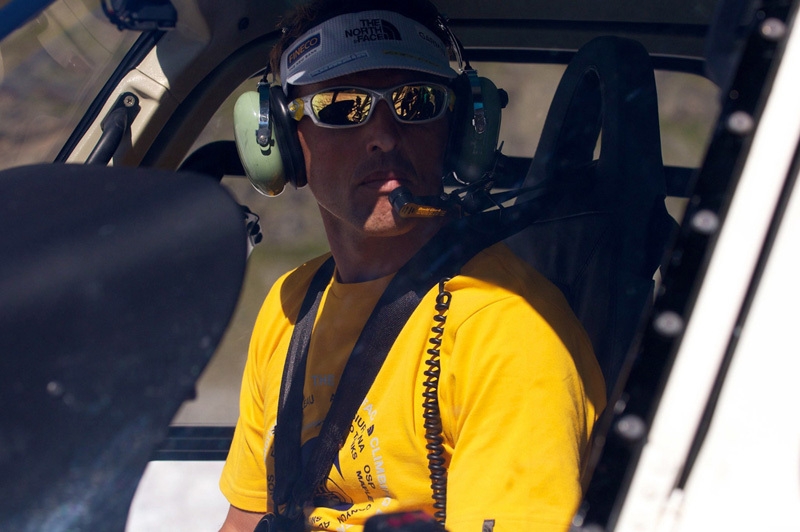Simone Moro between Everest, Lhotse and helicopter rescues

 1 / 4
1 / 4 archivio Simone Moro
archivio Simone Moro
It's nothing new that Simone Moro is an alpinist, and man, who is never content to do just one thing at a time. So while he's preparing (read acclimatising) for his "twin" ascent of first Everest, then Lhotse without descending to Base Camp, it comes as no surprise that he still manages to find the time to take part in various rescue operations. No real surprise, since his love for helicopters and Himalayan rescues is nothing new. The last month at Everest Base Camp has been hectic, with various rescue flights which have involved the Italian mountaineer such as the one carried out along with the formidable Italian pilot Maurizio Folini to rescue an injured Sherpa at 6000m. And of course there was also the flight which resulted in the evacuation of Cory Richards from Everest Base Camp, after the American alpinist and photographer (and partner on Gasherbrum in winter) was struck by altitude sickness - a problem which, for the record, has recurred.. We talked about all of this, and how his personal project is progressing, directly with Simone Moro via Skype...
Simone, some might ask, why Everest once again?
Well, some say that the 8000ers are like strawberries, one leads to the next. I don't like this comparison too much but, using the same fruit, I'd say that in a lifetime you don't just eat a single strawberry ;-) My times on Everest haven't been exalting (with partial use of supplementary oxygen...) but I remember them all as beautiful, personal moments. I've climbed the mountain from the south, from the north, I've done a traverse and I've ascended and descended Everest in 48 hours. All things which were worth experiencing.
So far this year's Everest has been split between acclimatising and rescues... how do you manage to concentrate on your climbing project?
At home I'm used to doing lots of things at the same time... so I've decided to use the enforced rest at Base Camp in a different way. Instead of pilgriming to all the others at Base Camp and chat about the usual things, whenever I'm not on the mountain I've decided to pilot the helicopter and lend a hand with rescues. I really enjoy flying and helping with rescues and, in all honesty, they seem to me far more useful than simply climbing a mountain ;-)
Tell us about the atmosphere, the people and the strange things at Everest Base Camp.
It's business as usual... lots of people, most of which are guides and clients. There's nothing wrong with this, it's a vital resource for the Nepalese economy. Personally I'm not disturbed by all these people and if I want solitude and exploration I just go elsewhere or in winter. Theres' so much you can do to isolate yourself in your own vertical world. The strange things I see here are nothing in comparison to what I read about in the "civilised" and "non-mountaineering" world.
Your carrying out plenty of rescues with your company... are things changing and if so, how?
Yes, FINALLY things are changing here, a lot and for the better. I'm delighted to have convinced Fishtailair in believing in me as a pilot and rescuer, and also in the Italian pilots. First Maurizio Folini from Valtellina and now Piergiorgio Rosati from Trento, who are making a big difference here. Professional, quick and tremendously good.
Do you see this rescue service in the Himalaya as something positive or negative? Or does it, as some say, lead to less able mountaineers doing imprudent things?
They're definitely something positive, no one up till now has abused the system with strange calls for a "high altitude taxi". Usually these "journeys" are carried from and to Base Camp, but on the mountain itself a strong sense of responsibility remains. Everyone knows, and remembers well, that flying a helicopter at 6000m and higher still can prove fatal.
We were struck by the altitude problems that Cory Richards had (you partner along with Denis Urubko during the first winter ascent of Gasherbrum II). Is this confirmation that you can never predict how your body will react to thin air?
Yes, this is completely the case. Everyone's had trouble, famous mountaineers and less famous alpinists, from thier 1st to their 10th 8000er. High altitude isn't a zone fit for humans, up there you simply cannot live and relax as usual...
How much "tourism" alpinism (to use a term coined by Reinhold Messner) is there on Everest and how much remains grass-roots, adventure alpinism.
I'd say 95 % client tourism and 5% adventure, exploration or performance alpinism.
We heard you're in good company at Base Camp...
At the moment I'm with Ueli Steck and Conrad Anker, they check in almost daily. And then there's also Gerlinde Kaltenbrunner and David Goettler. We've been friends for a long time now and I have a feeling that during these encounters some new projects are being made...
Talking of which... what about your project, that linkup of Everest and Lhotse without descending... When will you set off? And what do you reckon?
I reckon it'll be difficult, really difficult indeed. But I'm neither stressed out nor under pressure to perform. I'll set off around 23 or 24 May. I'll give it my best and hopefully I'll be lucky and succeed. The aim though is to return home safe and sound, regardless of whether I win or lose, as this is simply a different term used to describe someone for short while after a climb.
| Expo.Planetmountain | |
| Expo C.A.M.P. | |
| Expo La Sportiva | |
| Expo The North Face | |
| www | |
| www.simonemoro.com | |



 Copia link
Copia link























